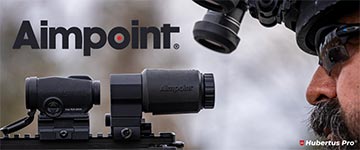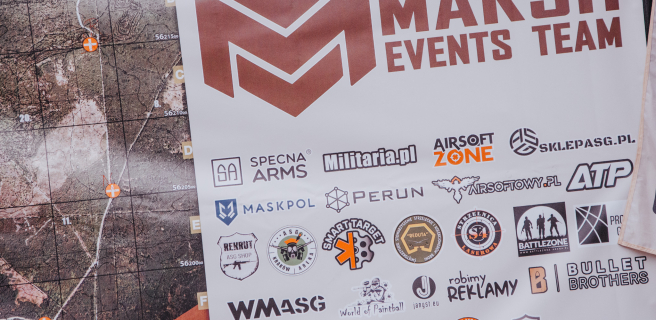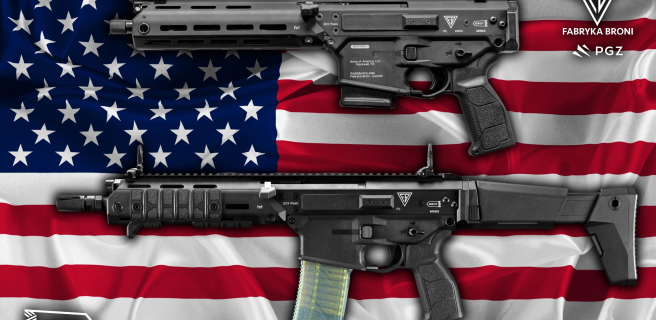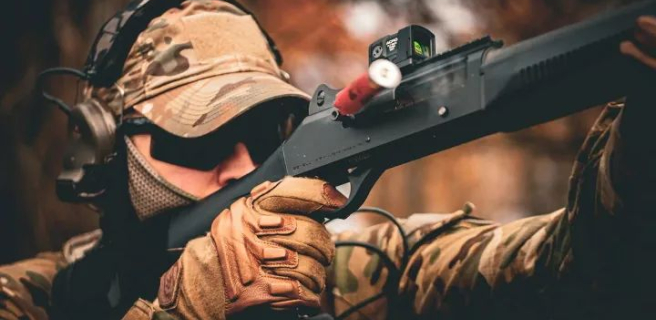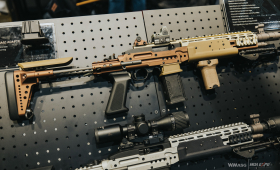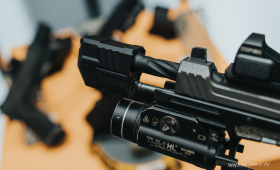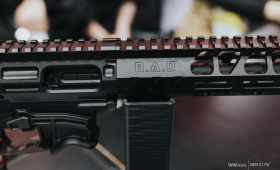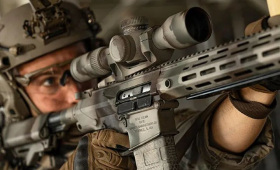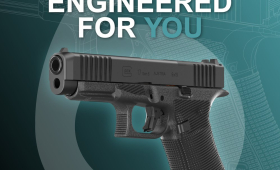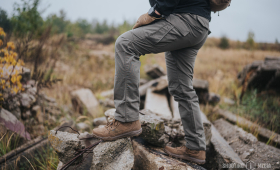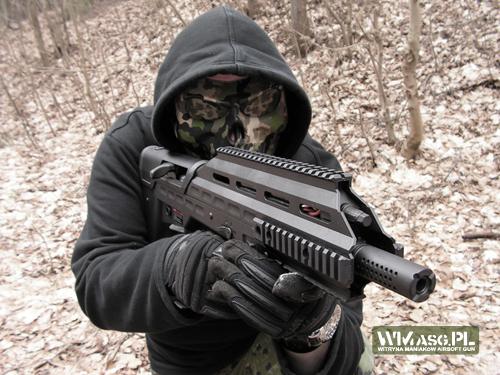 Concept bullpup rifle: AEG UAR (Urban Assault Rifle) by Chinese company APS Limited (Accuracy Pneumatics Shooting).
Concept bullpup rifle: AEG UAR (Urban Assault Rifle) by Chinese company APS Limited (Accuracy Pneumatics Shooting).
INTRODUCTION
AEG UAR is one of the products made by APS Limited (Accuracy Pneumatics Shooting). The UAR does not replicate any existing weapon, therefore is not truly a replica. It is a individual concept project of an airsoft rifle patented by APS.
PACKAGE
The AEG UAR package is a full cardboard box in a form of a case with the plastic carrying handle, opened at the top. The cover of the box is made form one of its longer sides.
The package is black and grey in color with white letters. It has APS and Hakkotsu logos.



The replica is secured with four inserts. Accessories are held inside a smaller box (the additional magazine, the stronger spring and the pack of BBs). The package serves its purpose very well. The only drawback was the fact that one of the magazines was loosely put into the box, which is a rather bad idea, as its hitting against the rifles body and may scratch it. (It is peculiar as the accessory box can hold both magazines inside).

Inside the box, apart from the rifle, we will find two magazines, an additional stronger spring, a manual, a pack of BBs and a cleaning rod.


Color manual is very detailed and illustrated with photos. It describes how to operate and disassemble the replica in great detail.




FIRST IMPRESSION
Compact size of the UAR and bullpup design make it very handy. It is comfortable to aim. The rifle is much heavier at the back but this is normal in case of bullpup models and does not negatively influence its use in any way.

The rifle is made ot of reinforced polymer. Some parts (e.g. the flash hider) are made from ZnAl alloy. Yet, external metal parts are very few. A different, original look is certainly the big pro for this rifle.


EXTERNAL APPERANCE
Basic replica parameters: length - 640 mm (25.19 in), weight - 2700 g (5.95 lbs). Inner barrel length: 385 mm (15.15 in).
Taking the UAR into ones hand gives a very positive impression. External finish is generally aesthetic and the quality of polymer used is very good. There are only minor mold leftovers and a few connection lines visible. The black polymer seems quite sturdy - it does not bend nor makes unpleasant sounds.
The AEG's design gives the used a long top rail for mounting sights and scopes. (The rifle does not come with any kind of sights - the user must buy either a set of rail mounted iron sights or a reflex sight).
The front of the rifle has two side rails and a bottom rail. (To shoot comfortably it is advised to use a vertical grip on the bottom rail. The rifle does not come with this part either).


The disassembled front part (upper body part). There are metal reinforcements in the area where the upper and lower parts come together.


A characteristic trait of the UAR is an ambidextrous magazine release button near the trigger and an ambidextrous fire selector switch. The magazine release button is not far from the trigger but people with short fingers (smaller hands) using the button with the same hand that holds the pistol grip may be troublesome.


The magazine release button rod.


Apart from the ambidextrous magazine release button nest to the trigger there is also a third release button next to the magwell. It has a form of a big square. The magazine release is done by “moving” the button downwards or pressing the lower part of the button. Yet we really do not know why this third button was added in the first place. When holding the rifle normally using the third button is not comfortable and is certainly not preferable over release button situated next to the trigger.


The trigger guard is spacious which enables one to shoot even with thick winter gloves. The shape of trigger is also quite interesting.

The AEG’s trigger is connected with the gearbox trigger with a rod. The force of pulling the trigger is therefore mechanically transferred to the trigger in the GB.




The fire selector switch has molded markings in the shape of skulls, but this form is not legible. The lever changes its position with a “click”. Overall the fire selector works very well and has no unnecessary slack. The firing modes positions and the workings of the switch are similar to the AK family of replicas. (Which is the result of using a V.3. Gearbox).


The fire selector switch of the UAR AEG is mechanically connected to the gearbox’s selector mechanism with a rod, which is comprised of two pieces.



The selector mechanism known from the V.3. gearboxes was modified.


The drawback is the placing of the selector switch itself. In the safe position is sticks out over the lower part of the body entering into the area of the trigger group. A slight movement of the of the finger held over the trigger is enough to switch the selector right into full auto mode.


In situations when we want to keep our finger off the trigger, moving the fire selector is practically unavoidable.

Also when trying to push the magazine release button, the fire selector switch is usually moved too.

The perforated flash hider is screwed in a 14mm counterclockwise thread and positioned with a small bottom hex screw.



The flash hider is one of the more interesting and well finished parts of the rifle.




The external barrel mount. The barrel is positioned with a metal ring screwed onto a thread.


The external barrel for M4 CQB was used.

The pistol grip. It is comfortable and not very massive, even for people with small hands.



Inside the grip there is a special compartment for storing CR123A batteries.




The stock houses the AEGs’ gearbox. The rifle has four sling attachment sockets – two at the front and two on the stock.



Metal sling QD attachment. (the AEG comes with only one such attachment)

The photo shows the pin holding the stock’s butt cover. The cover has the Hakkotsu skull molded on it.



The stock cover has a visible metal element which is a part of the dummy bolt release mechanism. The bolt catch works only when the stock cover in put on together with the top cover, which houses the bolt release button.



Taking off the stock cover allows for access to the rear part of the gearbox and for a quick spring exchange (without taking the GB out of the body). One only needs a hex wrench to turn and take out the spring guide and the spring out of the GB.


Spent casings ejection port. After putting back the charging handle stays in the rear position, which is to allow for comfortable HU adjustment (done with a sliding lever like in the AK family of replicas). The charging handle is released by pressing the bolt catch buttton.



Unfortunately, when set for right handed people, comfortable HU adjustment is impossible because the small lever used to adjust the HU is out of reach. It “hides” in the front part of the top cover and is inaccessible through the ejection port. The photos show the position of the sliding lever when the rifle is set for right handed people.



The rifle can be used without the ejection port cover, therefore allowing right handed people to have quick access to the HU from the left, but it may result in dust and dirt getting inside the body. The photo shows the ejection ports with the cover removed.

W układzie dla osób leworęcznych nie ma tego problemu, ponieważ występ suwaka po tej stronie komory jest łatwo dostępny.

An interesting feature is the possibility to switch the charging handle and the ejection port for either right or left handed people. This makes the UAR fully ambidextrous. The photo shows the dummy bolt and the part with the ejection ports.

The charging handle is secured with a “push in” button, therefore is can be easily removed and switched to the other side of the rifle together with the ejection port cover.



The bolt catch button is situated on the top rear part of the stock. In an airsoft replica it does not make a big difference since the bolt catch is used only to lock the dummy bolt in place while adjusting the HU. But in a real firearm it would be awkward, uncomfortable and completely out of accordance with the ergonomics of using a firearm.



The top stock cover (together with the bolt catch) is secured very loosely. It has no firm kind of a snap on or other king of securing mechanism. The inner latches seen in the photos do not perform their function. Their grip is to shallow and they easily slip out of the cutaways in the stock.
(Stronger vibrations or accidental hitting of the stock makes the cover to pop out. The AEG can be used without the top cover but then we eliminate the bolt catch button).
The stock cover together with the ejection ports and the ports’ cover:




The magwell.


MARKINGS
The UAR has a serial number and the airsoft caliber done in white and placed on the dummy bolt.


On the bottom of the body, between the pistol grip and the magwell, there are white marking placed: manufacturers name, country of origin and an information of patent pending.


POWER SUPPLY
The space for the battery is situated in the front part of the AEG, under the top rail. The space is very small. Its narrow size makes it possible to use only LiPostick or flat LiPo batteries divided into individual modules (preferably only two).

To connect / exchange the battery one must pull out a plastic part closing the battery compartment and then putting it back on. (Only the very end of the part, in the shape in a hex, is made of metal). The sides of this part act like springs and lock themselves in the sides of the body. Pulling the part out is quite uncomfortable and together with the need to align the battery and the cable in the tight compartment, increases the time needed to exchange the battery.




MAGAZINE
The manufacturer supplies the replica with two plastic magazines. These are short hi-caps housing 150 BBs.



The magazines have a slight slack in the magwell but with without problems. Unfortunately the AEG’s construction makes it impossible to use most of the mid-cap and low-cap magazines. The stock rifle can use mostly just hi-caps.


The photo below show the comparison of the top parts of UAR and PMAG Magpul magazines. The longer notch next to the feeding tube in the PMAG Magpul magazine does not allow for the magazine to be locked in the magwell.

The only mid-cap that would fit and fed well was a PMAG STAR 80. As you can see the notch next to the feeding tube is much shorter than in the Magpul magazine and only slightly longer than in the UAR magazine. (The second photo shows the comparison of PMAG Magpul and PMAG STAR magazines. The third photo compares the STAR magazine to the UAR magazine).



A user who wants to buy magazines other then hi-caps to the UAR AEG must compare the length of the notch with the UAR magazine. Hi-cap magazines work without problems. The only ones that did not work properly were short metal A.C.M. hi-caps – they had problems with feeding. They have too much slack and do not fit the magwell tightly enough – only after pressing them from the bottom did they start to feed properly.


APPEARANCE OF A PARTLY DISASSEMBLED REPLICA

The pins used in the UAR AEG are secured against falling out on their own.

The upper part of the GB and the HU chamber, from the top, before taking out of the body.

To take out the gearbox one must unscrew a screw connecting the GB with the HU chamber.

The HU chamber, together with the barrel assembly, is taken out after unscrewing four screws seen on the photos. Two are situated at the back, lower than the HU chamber, the other two at the front, one on each side of the barrel.




Then HU chamber can be separated after unscrewing two screws holding it to the base. The photo shows the “ears” of the chamber with the screws removed.

INTERNAL CONSTRUCTION
1. The gearbox.
The Hybrid V.3APSGB is compatible with the well known V.3. GB and it looks like the one used in the EBB replicas made by the company, with a characteristic cutaway at the top of the GB and the piston.
The internal parts make a very good impression. The only drawback was the excessive amount of grease, which had to be removed.







UAR AEG’s motor.


The gearbox has 8 mm bearigns.

The gears – made of steel, make a good impression. The motor gear has 4 anti-reversal latches. The piston gear has a sector clip (it delays the movement of the tappet plate).



The spring, which ends are not ground, is nonlinear, but only in the middle part. UAR AEG comes with two springs, which generate different FPS values.

The spring guide is made of polymer and steel and has ball bearings. The base of the guide is non standard – it has four notches – which is a part of the quick spring exchange mechanism.




The piston. It has seven metal teeth. The visible cutaway suggests that it is used in EBB replicas.



The nozzle is metal and has additional seals. (Its seal is excellent).


The cylinder - type 2 and the cylinder head. The seal of the piston / cylinder set is unfortunately quite poor.



2. HU Chamber.
The hop up chamber is made of metal. The inner barrel is 385 mm (15.15 in) long. The HU chamber is similar to the AK family replicas but not identical.

The black HU rubber is shorter than the standard one used in AEGs. In our opinion it is of poor quality, not elastic enough and qualifies for an immediate refit.



The part of the lever that act as the spacer pushing against the HU rubber is visibly cut flat, which is the reason behind the improper workings of the hop-up. This part can be exchanged however, using a part from a standard AKhop-up chamber.


SHOOTING
The shooting sound is pleasant to the ear. The workings of the gears is not audible. The overall performance of the mechanism was very good. Aiming and moving about with the UAR AEG is very comfortable.
Unfortunately the HUsystem does not work properly. It is difficult to adjust it and it easily gets out of adjustment by itself. This results in a frequent need to make adjustments and influences the effectiveness of shooting. The problem with the flawed construction of the HU part described above is the main reason for this situation.
TESTS
I) CQC spring:
1. FPS and energy measurements.
The FPS and energy tests were done using Aim Top 0,2 g BBs. The average muzzle velocity on those BBs is 333 fps with the energy of 1 J. (In out opinion the results were influenced by the poor seal of the piston - cylinder set).
Below is a table presenting 10 consecutive shots:
| fps | m/s | J | |
| 1 | 329.9 | 100.6 | 1 |
| 2 | 329.9 | 100.6 | 1 |
| 3 | 337 | 102.7 | 1.04 |
| 4 | 330.6 | 100.8 | 1 |
| 5 | 338.3 | 103.1 | 1.05 |
| 6 | 338.3 | 103.1 | 1.05 |
| 7 | 330.6 | 100.8 | 1 |
| 8 | 335 | 102.1 | 1.04 |
| 9 | 331.2 | 100.9 | 1 |
| 10 | 331.2 | 100.9 | 1 |
2. Accuracy and grouping at a distance of 30 m (32.80 yd).
The test was carried out using anA4 target with a background of a 1:1 silhouette.
Aim Top 0,20 g BBs were used.
At the distance of 30 m (32.80 yd)10 shots were fired.10/10 shots hit the silhouette, 7/10 the A4 target.

3. Maximum efficient and maximum total range
The maximum effective range, then most shits still hit the silhouette, is 40 m (43.74 yd). The maximum range of the replica can be estimated above 50 m (54.68 yd).
II) M120 spting:
1. FPS and energy measurements.
The FPS and energy tests were done using Aim Top 0,2 g BBs. The average muzzle velocity on those BBs 393 fps, with the energy of 1.4 J. (In out opinion the results were influenced by the poor seal of the piston - cylinder set).
Below is a table presenting 10 consecutive shots:
| fps | m/s | J | |
| 1 | 394 | 120.1 | 1.44 |
| 2 | 396.7 | 120.9 | 1.44 |
| 3 | 386.2 | 117.7 | 1.36 |
| 4 | 397.6 | 121.1 | 1.45 |
| 5 | 394.9 | 124 | 1.44 |
| 6 | 381.9 | 116.4 | 1.35 |
| 7 | 397.6 | 121.1 | 1.45 |
| 8 | 394.9 | 124 | 1.44 |
| 9 | 389.6 | 118.8 | 1.39 |
| 10 | 393.1 | 119.9 | 1.4 |
2. Accuracy and grouping at a distances of 40 m (43.74 yd).
The test was carried out using anA4 target with a background of a 1:1 silhouette.
Aim Top 0,25 g BBs were used.
At the distance of 40 m (43.74 yd) 10 shots were fired. 9/10 shots hit the silhouette, 5/10 the A4 target.

3. Maximum efficient and maximum total range
The maximum effective range, then most shits still hit the silhouette, is 50 m (54.68 yd). The maximum range of the replica can be about 65 m (71.08 yd).
SUMMARY
The APS UAR AEG, being a concept rifle made by Accuracy Pneumatics Shooting, is characterized by an interesting external appearance. It is handy and is well suited for fighting indoors. Despite the fact that it is not a replica of any real firearm – original appearance of the UAR is a definite pro and this AEG may find its enthusiasts.
The possibility of quick spring exchange and offering the AEG together with two springs allows to use the UAR both indoors and outdoors. The rifle has an aesthetic finish and makes an overall good impression.
Unfortunately the ergonomics of using the UAR leaves much to be desired. Difficulty in HU adjustments or involuntary switching of the fire selector are only the two most notable cons.
Despite the fact that the shooting itself is done without any obstructions and is comfortable, the poor workings of the hop-up system definitely impedes the use of the replica "out of the box". The lack of any sights that would come together with the replica can also discourage potential buyers.
In our opinion the Urban Assault Rifle is an interesting proposition for people looking not for a replica of a real firearm but for something original and standing out on the airsoft battlefield – under the condition that they will accept the listed drawbacks and the need to fix the HU system.
Pros:
+ original design
+ fully ambidextrous
+ aesthetic external finish
+ good quality of synthetic fibers used
+ good quality of internal parts
Cons:
- obstructed HU adjustment
- involuntary switching of the fire selector switch
- improper workings of the HU
- loose stock cover
- lack of any sights
The editors of WMasg would like to thank SHOGUN_YAMATO for lending us his replica for the review and his help in making it.
Translated by SHOGUN_YAMATO


